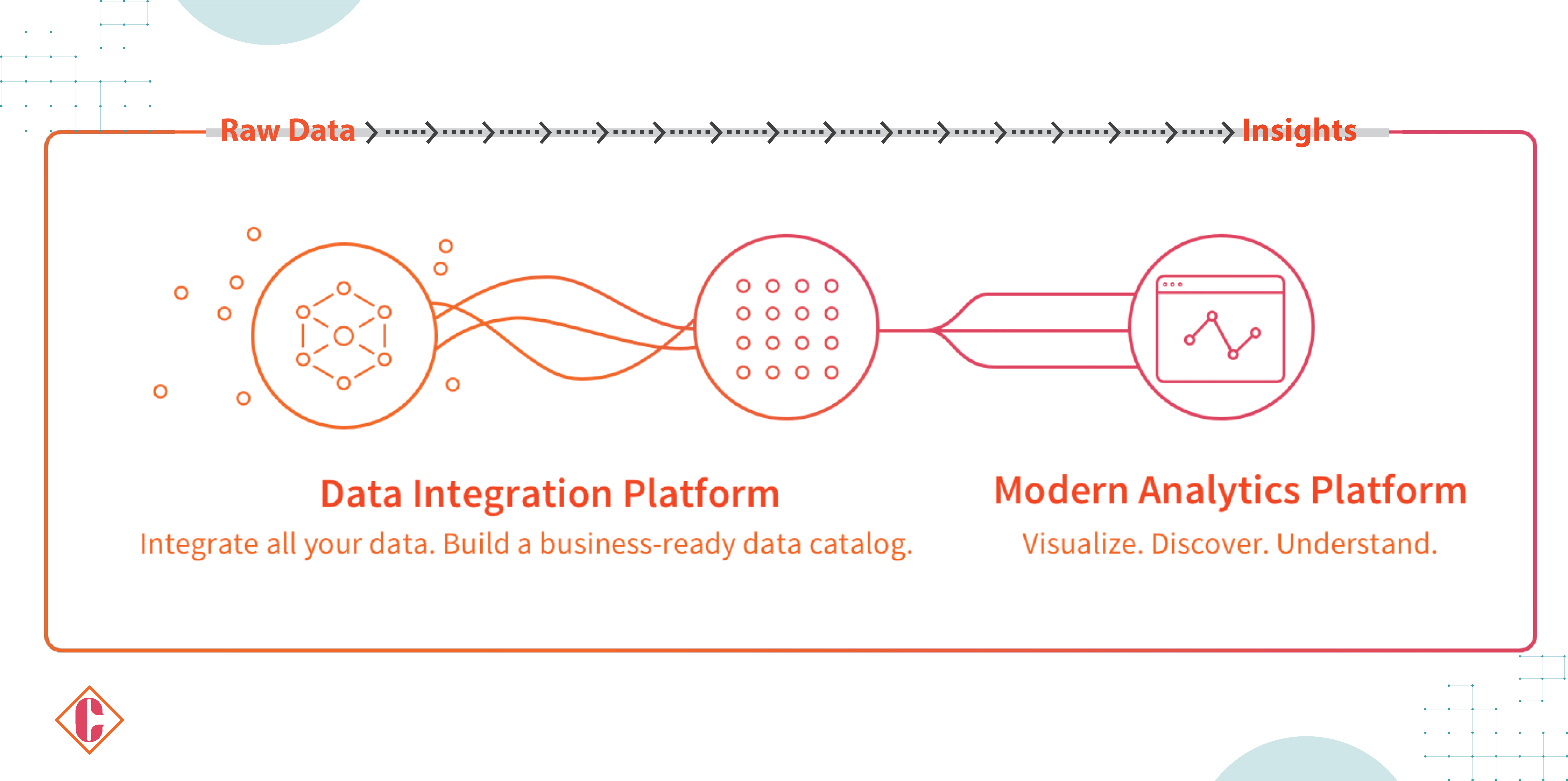The global big data analytics market is worth $274 billion and is expected to reach $425.9 billion by 2025, indicating a significant growth trajectory as per the reports from Exploding Topics. Businesses are inundated with information from various sources such as customer transactions, social media interactions, and sensor data. This vast pool of data, often termed big data, presents an opportunity for businesses to glean valuable insights, enhance decision-making, and gain a competitive edge.
However, navigating this sea of data necessitates robust big data analytics tools and techniques. Big data analytics holds a myriad of benefits for businesses, making it increasingly indispensable. Understanding customers deeply, and analyzing customer data provides businesses with insights into their preferences, purchasing behaviors, and sentiments, enabling them to tailor marketing strategies, craft targeted products and services, and elevate overall customer satisfaction levels.
Chief Information Officers (CIOs) serve as linchpins in fostering data-driven decision-making within organizations, tasked with overseeing IT infrastructure and data management strategies. CIOs establish a coherent data strategy outlining data collection, storage, management, and analysis procedures, carefully considering factors such as data governance, security, and access control. Investing in data infrastructure, CIOs select and implement hardware, software, and cloud-based solutions necessary for storing, processing, and analyzing big data, encompassing the choice of suitable data lakes, warehouses, and analytics platforms.
Also Read: How Big Data is Transforming the Oil and Gas Industry
Understanding Big Data Analytics
Big data analytics involves the collection, examination, and analysis of large volumes of data to uncover market trends, insights, and patterns, aiding companies in making informed business decisions. This information is swiftly accessible, enabling companies to adapt and maintain their competitive edge efficiently.
Utilizing technologies such as business intelligence (BI) tools and systems, organizations can amalgamate unstructured and structured data from various sources. Users, typically employees, input queries into these tools to gain insights into business operations and performance. Big data analytics employs four primary data analysis methods to unearth meaningful insights and derive actionable solutions.
What defines data as “big”?
Big data is characterized by the five V’s: volume, velocity, variety, variability, and value. Its complexity necessitates innovative technologies and analytical skills to make sense of the vast amount of data within the business context.
Benefits of Big Data Analytics
Faster, More Informed Decision Making
Businesses can leverage big data analytics to access vast volumes of data and analyze a wide array of data sources, enabling them to gain new insights and take decisive actions swiftly. Starting with small-scale initiatives, companies can gradually expand to handle data from both historical records and real-time sources.
Cost Reduction and Operational Efficiency
Utilizing flexible data processing and storage tools, organizations can significantly reduce costs associated with storing and analyzing large amounts of data. By uncovering patterns and insights, businesses can identify areas where operations can be conducted more efficiently, leading to cost savings and improved resource allocation.
Enhanced Data-Driven Go-to-Market Strategies
Analyzing data from diverse sources such as sensors, devices, video feeds, logs, transactional applications, and social media empowers organizations to adopt a data-driven approach. This enables companies to gauge customer needs, assess potential risks, and innovate by creating new products and services tailored to market demands.
IV. Overcoming Challenges in Big Data Analytics A. Data Quality and Integration Issues B. Security and Privacy Concerns C. Scalability and Infrastructure Requirements
V. Integrating Big Data Analytics into Business Strategy A. Aligning Analytics Initiatives with Organizational Goals B. Building a Data-Driven Culture Across Departments C. Collaborating with External Partners for Enhanced Insights
How Big Data Analytics Works
 The process of big data analytics entails several key steps: goal definition, data collection, data integration and management, data analysis, and sharing of findings. To handle the exploration and analysis of large volumes of semi-structured and unstructured data, advanced analytics tools are essential. These tools are typically utilized by data analysts, data scientists, or engineers, either through an end-to-end big data analytics platform or a comprehensive set of tools.
The process of big data analytics entails several key steps: goal definition, data collection, data integration and management, data analysis, and sharing of findings. To handle the exploration and analysis of large volumes of semi-structured and unstructured data, advanced analytics tools are essential. These tools are typically utilized by data analysts, data scientists, or engineers, either through an end-to-end big data analytics platform or a comprehensive set of tools.
Modern big data analytics incorporates artificial intelligence (AI) and machine learning to automate processes, offer insight suggestions, conduct predictive analytics, and enable natural language interaction. Real-time big data analytics involves processing data as it arrives, facilitating swift decision-making or triggering actions and notifications in real-time.
Top Big Data Analytics Solution Providers
-
Databricks Data Intelligence Platform
-
Alteryx
-
Snowflake
-
IBM Cloud Pak for Data
-
Teradata Vantage
-
Lenovo
Successful Implementations of Big Data Analytics
Siemens
Predictive Maintenance with Big Data:
- Siemens equips their industrial equipment with sensors that collect real-time data on various parameters like temperature, vibration, and energy consumption.
- This data is fed into big data analytics platforms that use advanced algorithms to identify patterns and anomalies indicative of potential equipment failures.
- Based on these insights, Siemens can predict equipment failures before they occur and schedule preventive maintenance at optimal times.
Benefits:
- Minimized downtime: By proactively addressing potential issues, Siemens significantly reduces the risk of unexpected equipment failures and unplanned downtime.
- Increased operational efficiency: Preventive maintenance ensures equipment operates at peak performance, leading to smoother production processes and higher output.
- Cost savings: Avoiding major breakdowns and repairs translates to significant cost savings in terms of repair expenses, lost production time, and potential product quality issues.
Amazon
Recommending Products:
- Amazon analyzes customer purchase history, browsing behavior, and product reviews to recommend products that are likely to be of interest to individual customers.
- This personalization enhances the customer experience and encourages them to explore new products they might not have considered otherwise.
- Increased sales: Relevant product recommendations lead to higher conversion rates and increased basket size.
Personalizing Search Results:
- Amazon tailors search results based on individual customer’s past searches, purchase history, and browsing behavior.
- This ensures that customers see products they are more likely to be interested in, saving them time and effort in their search journey.
- Improved customer satisfaction: A personalized search experience leads to faster product discovery and higher customer satisfaction.
Dynamically Adjusting Prices:
- Amazon uses real-time data on demand, competitor pricing, and inventory levels to dynamically adjust prices for certain products.
- This allows them to optimize pricing strategies to remain competitive and maximize profitability.
- Increased sales: Competitive pricing strategies attract more customers and lead to increased sales volume.
Overall Impact:
By leveraging big data analytics Amazon has gained significant advantages in their respective markets. These strategies have contributed to their dominant positions by:
- Reducing costs through efficient operations and targeted marketing.
- Increasing sales by offering a personalized and convenient shopping experience.
- Improving customer satisfaction by meeting their needs and expectations effectively.
Future Outlook
The future of big data analytics is brimming with exciting possibilities. Emerging trends like real-time analytics and edge computing will enable faster and more localized insights, empowering businesses to make data-driven decisions in real time. The growing influence of artificial intelligence (AI) and machine learning (ML) will further revolutionize the field, allowing for automated data analysis, anomaly detection, and even the generation of synthetic data. These advancements will unlock deeper insights from complex datasets, leading to improved decision-making, personalized experiences, and optimized operations across various industries. As big data continues to evolve, we can expect even more sophisticated analytics tools, robust data governance frameworks, and a growing emphasis on explainability and ethical considerations. This confluence of trends paves the way for a future where big data analytics becomes an integral part of every organization’s decision-making process, driving innovation and shaping a data-driven future.
FAQs
1. What are the different types of big data analytics?
Descriptive analytics: Summarizes and describes historical data to understand past trends and patterns.
Predictive analytics: Uses historical data and statistical models to predict future outcomes and trends.
Prescriptive analytics: Recommends specific actions based on data analysis to optimize outcomes and achieve desired goals.
2. What are the future trends in big data analytics?
Real-time analytics: Enabling faster insights and decision-making based on real-time data streams.
Edge computing: Processing data closer to its source for faster analysis and reduced latency.
Artificial intelligence and machine learning: Increasingly powerful AI and ML algorithms for automated data analysis and deeper insights.
Focus on explainability and ethics: Ensuring transparency and ethical considerations in data collection, analysis, and decision-making.
3. What are the ethical considerations of big data analytics?
- Data privacy: Ensure compliance with data privacy regulations and protect sensitive information.
- Bias and fairness: Be aware of potential biases in data collection and analysis that could lead to discriminatory outcomes.
- Transparency and explainability: Make data-driven decisions transparent and explainable to build trust and avoid unintended consequences.
[To share your insights with us as part of editorial or sponsored content, please write to sghosh@martechseries.com]


